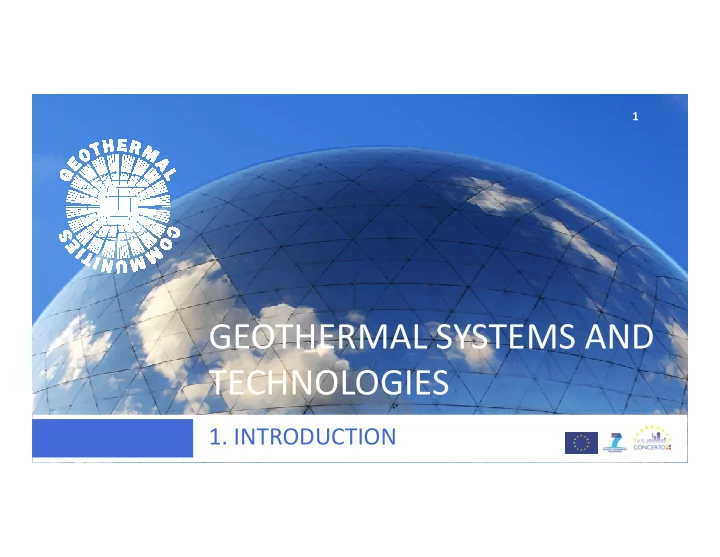

1 GEOTHERMAL SYSTEMS AND TECHNOLOGIES 1. INTRODUCTION
1. INTRODUCTION 2 The word "geothermal" comes from the combi- nation of the Greek words: ⇒ meaning Earth, and � gê ⇒ meaning heat ⇒ meaning heat � thérm � thérm It is considered as renewable resource because the heat emanating from the interior of the Earth is essentially limitless. The heat of the earth is available everywhere, and we are learning to use it in a broader diversity of circumstances.
1.INTRODUCTION 3 Spatial variations of the thermal energy within the deep crust and mantle of the Earth give rise to concentrations of thermal energy near the surface of the Earth that can be used as an energy resource. near the surface of the Earth that can be used as an energy resource. Heat is transferred from the deeper portions of the Earth by conduction through rocks, by the movement from hot, deep rocks toward the surface, and by deep circulation of water. Most high-temperature geothermal resources are associated with concentrations of heat caused by the movement of magma (melted rock) to near-surface positions where the heat is stored.
1.INTRODUCTION 4 The Earth is consisted of crust, mantle and core. The physical and chemical characteristics The physical and chemical characteristics of the crust, mantle and core vary from surface of the Earth to its center. Inner structure of the Earth
1.INTRODUCTION 5 Lithosphere, is made up of the crust and the upper layer of the mantle and it is behaves as a rigid body. (80-200 km) body. (80-200 km) Below the lithosphere is the asthenosphere, 200-300 km in thickness. Cross section of the Earth
1.INTRODUCTION 6 According to Stacey and Loper (1988), the total flow of heat from the Earth is estimated at 42 x 10 12 W of which: � 8 x 10 12 W comes from the crust 8 x 10 W comes from the crust � 32.3 x 10 12 W comes from the mantle and � 1.7 x 10 12 W comes from the core. Since the radiogenic heat of the mantle is estimated at 22 x 10 12 W, the cooling rate of this part of the Earth is 10.3 x 10 12 W.
1.INTRODUCTION 7 With increasing depth through crust, from the surface to the Earth interior, temperature increases for 17 - 30 o C/km. This temperature increase is called the temperature gradient and it varies based on factors such as: varies based on factors such as: � the porosity of the rock, � the degree of liquid saturation of the rock and sediments, � their thermal conductivity, � their heat storage capacity, and � the vicinity of magma chambers or heated underground reservoirs of liquid.
1.INTRODUCTION 8 Temperature gradient is different in different parts of the Earth ranging from 10 to over 80 o C/km. Average temperature gradient is ∼ 30 o C/km. Average temperature gradient is ∼ 30 C/km. The mean terrestrial heat flow of continents and oceans is 65 and 101 W/m 2 , respectively, which, when really weighted, yield a global mean of 87 W/m 2 . Temperature profile of the Earth’s crust
1.INTRODUCTION 9 Average geothermal heat flow through the crust to the Earth surface, with a temperature gradient of 30 o C/km is 0.06 W/m 2 . For regions with higher temperature For regions with higher temperature gradient, geothermal heat flow is 10-20 W/m 2 . The estimated total thermal energy above mean surface temp. to a depth of 10 km is 1.3 x 10 27 J, equivalent to burning 4.8 x 10 19 liters of oil .
1.INTRODUCTION 10 Since the global energy consumption for all types of energy, is equivalent to use of about 16 billion liters of oil per day, the Earth’s energy to a depth of 10 km could theoretically supply all of mankind’s energy needs for six million years. all of mankind’s energy needs for six million years. Earth's mantle is composed of highly viscous, partially molten rock, with temperature of 600÷1250 o C at a depth of about 80÷100 km. Earth's core is composed of outer liquid and inner solid core, with temperature from 4000÷7000 o C.
1.INTRODUCTION 11 In the foreseeable future geothermal energy will not meet more than a very few percent of the total energy consumption of the world, but it is of great importance for many of the individual countries to harness it. Geothermal research is now under way in about 60 Geothermal research is now under way in about 60 countries. Most of these are developing countries. All existing applications of GE use a circulating fluid to carry the heat from depth to its use at the surface. Otherwise, enhanced techniques are available. Fluids produced at lower temperatures (below ∼ 80 o C) are used for space heating, food drying, or industrial processes. Geothermal fluids with higher temperature and sufficient flow rate can be used to generate electricity.
1.INTRODUCTION 12 Main characteristics of geothermal energy which makes it a very important future energy source are: Extensive global distribution, Extensive global distribution, � � Environmentally friendly, � Sustainable resource, � Independent of season and day time, � Immune from weather effects, � Contributes to development of � diversified power sources, and Effective for distributed application. �
Recommend
More recommend